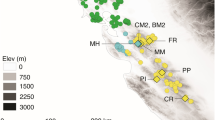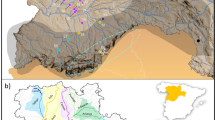Abstract
The amount and distribution of genetic variation in seven introduced New Zealand populations of Carduelis chloris were assessed at 40 loci using starch gel electrophoresis and compared with those in native European populations. Fewer alleles (1.45) and fewer polymorphic loci (33 per cent) were detected across the introduced populations than across native populations (1.75, 55 per cent), reflecting the narrow geographical origin of the introduced populations. There was no evidence for severe inbreeding or genetic drift as the levels of average heterozygosity (H = 0.025), percentage polymorphic loci (P = 16.9) and average number of alleles per locus (A = 1.22) were indistinguishable from levels observed within European populations (77 = 0.025, P =14.1, A = 1.19). Furthermore, introduced populations were genetically less weakly differentiated (FST = 0.022) than native populations (FST = 0.041), indicating that little genetic drift has been involved in the colonization of the new range. Similar levels of genetic variability in native and introduced greenfinch populations are consistent with theoretical expectations as the founder population size was relatively large (>60 individuals) and a rapid increase in population size directly after colonization was documented. A review of earlier studies on introduced birds also revealed that reductions in levels of genetic variability seem to be inversely proportional to the size of the founder population, and that less variation has been lost if the rate of population growth directly after introduction was fast.
Similar content being viewed by others
Article PDF
References
Archie, J W. 1985. Statistical analysis of heterozygosity data: independent sample comparisons. Evolution, 39, 623–637.
Baker, A J. 1992. Genetic and morphometric divergence in ancestral European and descendent New Zealand populations of chaffinches(Fringilla coelebs). Evolution, 46, 1784–1800.
Baker, A J, and Dennison, M D. 1991. Population differentiation in colonizing species of birds. In: Quellet, H. (ed.) Acta XX Congressus Internationalis Omithologici, pp. 504–513. Ornithological Congress Trust Board, New Zealand.
Baker, A J, and Moeed, A. 1987. Rapid genetic differentiation and founder effect in colonizing populations of common mynas (Acridotheres tristis). Evolution, 41, 525–538.
Baker, A J, Peck, M K, and Goldsmith, M A. 1990. Genetic and morphometric differentation of introduced populations of Common Chaffinches (Fringilla coelebs) in New Zealand. Condor, 92, 76–88.
Barrowclough, G F, Johnson, N K, and Zink, R M. 1985. On the nature of genie variation in birds. Curr Ornithol, 2, 135–154.
Barton, N, and Charlesworth, B. 1984. Genetic revolutions, founder effects and speciation. Ann Rev Ecol Syst, 15, 133–164.
Berlocher, S H. 1984. Genetic changes coinciding with the colonization of California by the walnut husk fly, Rhagoletis completa. Evolution, 38, 906–918.
Bonnell, M L, and Selander, R K. 1974. Elephant seals: genetic variation and near extinction. Science, 184, 908–909.
Bryant, E H, Van Dijk, H, and Van Delden, W. 1981. Genetic variability of the face fly, Musca autumnalis De Geer, in relation to a population bottleneck. Evolution, 35, 872–881.
Burdon, J J, and Brown, A H D. 1986. Population genetics of Echium plantagineum L.—target weed for biological control. Aust J Biol Sci, 39, 369–378.
Carson, H L, and Templeton, A R. 1984. Genetic revolutions in relation to speciation phenomena: the founding of new populations. Ann Rev Ecol Syst, 15, 97–131.
Chakraborty, R, Fuerst, P A, and Nei, M. 1980. Statistical studies on protein polymorphism in natural populations. III. Distribution of allele frequencies and the number of alleles per locus. Genetics, 94, 1039–1063.
Cleog, M T, and Brown, A H D. 1983. The founding of plant populations. In: Schonewald-Cox, C. M., Chambers, S. M., MacBryde, B. and Thomas, L. (eds) Genetics and Conservation, pp. 216–228. Benjamin Cummings, Menlo Park, CA.
Cockerham, C C, and Weir, B S. 1993. Estimation of gene flow from F-statistics. Evolution, 47, 855–863.
Cramp, S, and Perrins, C M. 1994. The Birds of the Western Palearctic, vol. VIII. Oxford University Press, Oxford.
Felsenstein, J. 1993. PHYLIP (Phylogeny Inference Package) version 35c. (Distributed by the author.) Department of Genetics, University of Washington, Seattle.
Gallardo, M H, Köhler, N, and Araneda, C. 1995. Bottleneck effects in local populations of fossorial Ctenomys (Rodentia, Ctenomyidae) affected by vulcanism. Heredity, 74, 638–646.
Glover, D E, and Barret, S C H. 1987. Genetic variation in continental island populations of Eichhomia paniculata (Pontederiaceae). Heredity, 59, 7–17.
Goudet, J. 1995. FSTAT, a program for IBM PC compatibles to calculate Weir and Cockerham's 1984 estimators of F-statistics, ver. 1.2. Distributed by J. Goudet, University of Lausanne, Switzerland.
Hoelzel, A R, Halley, J, O'Brien, S J, Campagna, C, Arnbom, T, Le Boeuf, B, Ralls, K, and Dover, G A. 1995. Elephant seal genetic variation and the use of simulation models to investigate historical population bottlenecks. J Hered, 84, 443–449.
International Union of Biochemistry and Molecular Biology. 1992. Enzyme Nomenclature, 1992. Academic Press, San Diego, CA.
Korsström, H. 1927. Merenkulun oppikirja. Valtion kirjapaino, Helsinki.
Leberg, P L. 1992. Effects of population bottlenecks on genetic diversity as measured by allozyme electrophoresis. Evolution, 46, 477–494.
Lessios, H A. 1992. Testing electrophoretic data for agreement with Hardy-Weinberg expectations. Mar Biol, 112, 517–523.
Lever, C. 1987. Naturalised Birds of the World. Longman Scientific&Technical, Harlow, Essex.
Long, J L. 1981. Introduced Birds of the World The Worldwide History, Distribution and Influence of Birds Introduced to New Environments. David&Charles, London.
Manly, B F J. 1991. Randomization and Monte Carlo Methods in Biology. Chapman and Hall, London.
Maruyama, T, and Fuerst, P A. 1985. Popuation bottle- necks and nonequilibrium models in population genetics. II. Number of alleles in a small population that was formed by a recent bottleneck. Genetics, 111, 675–689.
McCommas, S A, and Bryant, E H. 1990. Loss of electrophoretic variation in serially bottlenecked populations. Heredity, 64, 315–321.
Merilä, J, Björklund, M, and Baker, A J. 1996. Genetic population structure and gradual northward decline of genetic variability in the Greenfinch (Carduelis chloris). Evolution (in press).
Molina-Freaner, F, and Jain, S K. 1992. Isozyme variation in Californian and Turkish populations of the colonizing species. Trifolium hirtum J Hered, 83, 423–430.
Nei, M. 1978. Estimation of average heterozygosity and genetic distance from a small number of individuals. Genetics, 89, 583–590.
Nei, M. 1986. Definition and estimation of fixation indices. Evolution, 40, 643–645.
Nei, M, Maruyama, T, and Chakraborty, R. 1975. The bottleneck effect and genetic variability in populations. Evolution, 29, 1–10.
Novak, S J, and Mack, R N. 1993. Genetic variation in Bromus tectorum (Poaceae): comparison between native and introduced populations. Heredity, 71, 167–176.
Parkin, D T, and Cole, S R. 1985. Genetic differentiation and rates of evolution in some introduced populations of the House Sparrow, Passer domesticus in Australia and New Zealand. Heredity, 54, 15–23.
Polans, N O, and Allard, R W. 1989. An experimental evaluation of the recovery potential of ryegrass populations from genetic stress resulting from restriction of population size. Evolution, 43, 1320–1324.
Porter, A H. 1990. Testing nominal species boundaries using gene flow statistics: the taxonomy of two hybridizing admiral butterflies (Limenitis: Nymphalidae). Syst ZooL, 39, 131–147.
Raymond, M, and Rousset, F. 1995a. GENEPOP (Version 1.2): population genetics software for exact tests and ecumenicism. J Hered, 86, 248–249.
Raymond, M, and Rousset, F. 1995b. An exact test for population differentiation. Evolution, 49, 1280–1283.
Rice, W R. 1989. Analyzing tables of statistical tests. Evolution, 43, 223–225.
Rogers, J S. 1972. Measures of Genetic Similarity and Genetic Distance. University of Texas Publ. no. 7213, pp. 145–153.
Ross, H A. 1983. Genetic differentiation of Staring (Sturnus vulgaris: Aves) in New Zealand and Great Britain. J ZooL, Lond, 201, 351–362.
Saitou, N, and Nei, M. 1987. The Neighbor-Joining method: A new method for reconstructing phylogenetic trees. Mol Biol Evol, 4, 406–425.
Slatkin, M. 1993. Isolation by distance in equilibrium and non-equilibrium populations. Evolution, 47, 264–279.
Sokal, R R, and Rohlf, F J. 1981. Biometry, 2nd edn. Freeman, New York.
St Louis, V, and Barlow, J C. 1988. Genetic differentiation among ancestral and introduced populations of the Eurasian tree sparrow (Passer montanus). Evolution, 42, 266–276.
Schwaegerle, K E, and Schaal, B A. 1979. Genetic variability and founder effect in the pitcher plant Sarracenia purpurea L. Evolution, 33, 1210–1218.
Swofford, D L, and Selander, R B. 1989. BIOSYS-1. A computer program for the analysis of allelic variation in population genetics and biochemical systematics. Release 1.7.University of Illinois, Urbana, IL.
Taylor, C E, and Gorman, G C. 1975. Population genetics of a “colonising” lizard: natural selection for allozyme morphs in Anolis grahami. Heredity, 35, 241–247.
Taylor, A C, Sherwin, W B, and Wayne, R K. 1995. Genetic variation of microsatellite loci in a bottle-necked species: the northern hairy-nosed wombat Lasiorhinus krefftii. Mol Ecol, 3, 277–290.
Templeton, A. 1980. The theory of speciation via founder principle. Genetics, 94, 1011–1038.
Thomson, G M. 1922. The Naturalisation of Animals and Plants in New Zealand. Cambridge University Press, London.
Vásquesz Phillips, M. 1992. Population Differentiation of the House Finch (Carpodacus mexicanus) in North America and the Hawaiian Islands. M.Sc. thesis, University of Toronto and Royal Ontario Museum.
Verspoor, E. 1988. Reduced genetic variability in first generation hatchery populations of Atlantic salmon (Salmo salar). Can J Fish Aquat Sci, 45, 1686–1690.
Wade, M J, and McCauley, D E. 1988. Extinction and recolonization: their effects on the genetic differentiation of local populations. Evolution, 42, 995–1005.
Warwick, S I, Thompson, B K, and Black, L D. 1987. Genetic variation in Canadian and European populations of the colonizing weed species. Apera spica-venti New Phytol, 106, 301–317.
Watterson, G A. 1984. Allele frequency after a bottleneck. Theor Pop Biol, 26, 387–407.
Weir, B S, and Cockerham, C C. 1984. Estimating F-statistics for the analysis of population structure. Evolution, 38, 1358–1370.
Whitlock, M C, and McCauley, D E. 1990. Some population genetic consequences of colony formation and extinction: genetic correlations within founding groups. Evolution, 44, 1717–1724.
Wolf, P G, and Soltis, P S. 1992. Estimates of gene flow among populations, geographic races, and species in the fpomopsis aggregata complex. Genetics, 130, 639–647.
Acknowledgements
Acknowledgements We thank Staffan Ulfstrand and anonymous refer-erees for thouhgtful reading of manuscript, and for several suggestions which have improved it. Special thanks to Mark Peck for his invaluable help both in field and lab. This study was financially supported by the Canadian National Environmental Research Council (to AJB), The Swedish Natural Science Research Council (to MB), The Royal Swedish Academy of Sciences, and Stiftelsen Zoologisk Forskning at Uppsala University (to JM).
Author information
Authors and Affiliations
Corresponding author
Rights and permissions
About this article
Cite this article
Merilä, J., Björklund, M. & Baker, A. The successful founder: genetics of introduced Carduelis chloris (greenfinch) populations in New Zealand. Heredity 77, 410–422 (1996). https://doi.org/10.1038/hdy.1996.161
Received:
Issue date:
DOI: https://doi.org/10.1038/hdy.1996.161
Keywords
This article is cited by
-
Mitochondrial genomes reveal diverse lineages of Diaphorina citri Kuwayama (Hemiptera: Sternorrhyncha: Psyllidae) in Kenya and La Réunion
Biological Invasions (2021)
-
Assessment of the dunnocks’ introduction to New Zealand using innate immune-gene diversity
Evolutionary Ecology (2020)
-
The ins and outs of acclimatisation: imports versus translocations of skylarks and starlings in 19th century New Zealand
Biological Invasions (2019)
-
Population mitogenomics provides insights into evolutionary history, source of invasions and diversifying selection in the House Crow (Corvus splendens)
Heredity (2018)
-
Genetic differentiation between introduced Central European sika and source populations in Japan: effects of isolation and demographic events
Biological Invasions (2017)



